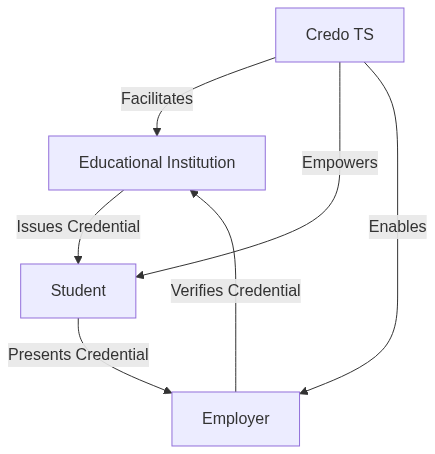Verifiable Credentials in Modern Education: The Credo TS Solution

Introduction
In an increasingly digital world, the need for secure and easily verifiable credentials is becoming paramount, especially in education. Verifiable Credentials (VCs) offer a revolutionary approach to issuing, storing, and validating educational achievements. This post explores the importance of VCs in modern education and introduces Credo TS, a powerful tool for implementing this technology.
The Need for Verifiable Credentials in Education
Traditional credential verification processes are often slow, prone to errors, and vulnerable to fraud. These challenges have significant implications for educational institutions, students, and employers alike. Digital, verifiable credentials address these issues by providing a secure, tamper-evident, and instantly verifiable format for educational achievements.
Consider these statistics:
- According to a 2018 study, 85% of employers uncovered lies or misrepresentations on resumes and job applications.
- Verifiable Credentials can significantly reduce the time and resources spent on background checks and credential verification.
The core concept of Verifiable Credentials revolves around three key entities:
- The issuer (educational institution)
- The holder (student)
- The verifier (employer or other institution).
This ecosystem ensures that credentials are trustworthy, portable, and easily verifiable.
How Verifiable Credentials Transform Education
Verifiable Credentials offer numerous benefits for all stakeholders in the educational ecosystem:
For educational institutions
- Reduced administrative burden
- Enhanced reputation through secure credential issuance
- Improved ability to track and verify lifelong learning achievements
Students
- Full control over their credentials
- Easy sharing of achievements with potential employers
- Seamless integration of formal and informal learning experiences
For employers
- Instant verification of applicants' credentials
- Reduced risk of credential fraud
- More efficient hiring processes
Real-World Examples of Verifiable Credentials in Education
To better understand the impact of Verifiable Credentials in education, let's explore some real-world examples and use cases:
1. Digital Diplomas at MIT
Massachusetts Institute of Technology (MIT) has been a pioneer in implementing blockchain-based digital diplomas. In 2017, MIT issued digital diplomas to 111 graduates using the Blockcerts open standard, which is compatible with Verifiable Credentials.
Impact: This initiative has made it easier for MIT graduates to share their credentials with employers globally, reducing verification time and enhancing the authenticity of their qualifications.
Source: MIT News
2. Open University's OpenLearn Badges
The Open University in the UK uses digital badges, a precursor to full Verifiable Credentials, for their OpenLearn free courses. These badges can be displayed on social media profiles and digital CVs.
Impact: Learners can showcase their continuous learning efforts, even from informal educational experiences, enhancing their employability and personal development.
Source: The Open University
3. Hyland Credentials for Higher Education
Hyland, a content services provider, offers a Verifiable Credentials solution specifically for higher education institutions. Several universities, including Central New Mexico Community College, have adopted this system.
Impact: Students receive tamper-evident, blockchain-anchored credentials that they own and can share instantly with employers or other institutions.
Source: Hyland Credentials
Implementing Verifiable Credentials with Credo TS
Credo TS is a TypeScript framework designed for building decentralized identity and verifiable credential solutions. It offers a robust set of tools for educational institutions to implement VCs effectively.
Key features of Credo TS for educational institutions include:
- Easy integration with existing systems
- Support for multiple credential formats
- Secure credential issuance and verification
- Interoperability with other decentralized identity solutions
Credo TS simplifies the process of issuing, holding, and verifying credentials, making it easier for educational institutions to adopt this technology. By leveraging Credo TS, institutions can focus on the value they provide through their credentials rather than the technical complexities of implementation.
The Verifiable Credentials Ecosystem
To better understand how Verifiable Credentials work in practice, let's visualize the ecosystem:
This diagram illustrates the circular trust relationship between the issuer (educational institution), holder (student), and verifier (employer). Credo TS acts as the underlying technology that facilitates this ecosystem, ensuring secure and efficient credential management.
Future of Education with Verifiable Credentials
The future of education with Verifiable Credentials is promising. We can expect to see:
- Seamless integration of micro-credentials and lifelong learning achievements
- Enhanced global recognition of qualifications
- Automated credential verification in job application processes
- Personalized learning pathways based on verified skills and knowledge
As the technology matures, we may see the emergence of global credential networks, where achievements from various institutions can be easily combined and verified. This could lead to more flexible and personalized educational journeys, better aligned with the rapidly changing needs of the job market.
Conclusion
Verifiable Credentials are set to revolutionize how educational achievements are issued, shared, and verified. By implementing solutions like Credo TS, educational institutions can enhance the value and utility of the credentials they issue, benefiting students, employers, and the broader educational ecosystem.
The adoption of Verifiable Credentials represents a significant step towards a more transparent, efficient, and trustworthy educational landscape. As we move forward, it's crucial for educational institutions to stay informed about these technological advancements and consider how they can leverage tools like Credo TS to improve their credential issuance and verification processes.

